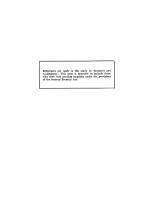Ideology and Organization in Communist China [Reprint 2020 ed.] 9780520311152
203 100 53MB
English Pages 700 [704] Year 2020
Recommend Papers
![Ideology and Organization in Communist China [Reprint 2020 ed.]
9780520311152](https://ebin.pub/img/200x200/ideology-and-organization-in-communist-china-reprint-2020nbsped-9780520311152.jpg)
- Author / Uploaded
- Franz Schurmann
File loading please wait...
Citation preview
mkhnv($[
re
« H . »
••
ÎtUËS i t
tl.S
¡"chuar
Koko Nor, >"gHai )
Tungwei
,Ch
ingliamlia
i
No
T a l
anchung
,Poonj ^ongfinc
W
M
iWanhsiennHi -Chunghsien
weiya.ag ^ YUNNAf. T
*uyungo
TEA)f'jA
LiuchiKr i Szengen KWAIANCf rtHUAlÎG-λ'!' sr
ÈPH (LungeKow) MW
^youkpyc
Tonkin
Ihongpe/jChengt . « A t » ' % (Jehol)
ilNGTAO & f •TieyanQ
Wams "ma
j
iianawl Nanyanp,
¡fewiw^
A S
¡ ¡ j S & N G H A l g|fcn(lù»n6
SfrafiKsing
-
CÄKUHG
'
Chuhsien
VIHÌW» RihkiaW Shaoyang
L
S i
/>
Ä l M b s i M - y
> 'TAIWAN. iCHINÄ
CHINA
i i K Ö B ® L v i c t o r i a . S S I N ^ ? ^ HONGKÖlte (Br.)
;
1
SSSi.
. s o u r «
CHINA
Political
SEA
National capitals
PEKING
Secondary capital*
SIAN
Railroads
n period," and again in December 1953 to discuss "the draft -proposal on the strengthening of internal Party solidarity" which was to be presented to the Fourth Plenum; 51 likewise it was revealed that there was an enlarged meeting of the Politburo in August 1958 in the resort town of Peitaiho which decided on the formation of the people's communes and the intensification of action in the Taiwan Straits;52 again we know that there was an enlarged meeting of the Politburo in February 1959 in Chengchow which discussed reorganization of the people's communes.53 si Jenmin jihpao, February 18, 1954. 82 Ibid., September 1, 1958. 53 Chungkung shihnien, p. 11.
PARTY
147
Undoubtedly every plenary or nonplenary meeting of the Central Committee is preceded by a full or enlarged meeting of the Politburo. T h e "enlarged" (k'uota) meetings of the Politburo or the Central Committee include outside individuals expected to be of use in formulating the final decisions. T h e scholar K. C. Chao has stated: "The present large-size of the Central Committee combined with the relative infrequency of its meetings has made it more and more difficult for that body to play a major role in the day-to-day decisions of the party." 84 It is doubtful, however, whether the full Central Committee has, in recent times, ever concerned itself with "the day-to-day decisions of the Party." Decision-making, where it occurs collectively, requires a small, manageable group. T h e larger the group, the more formalized the situation, and the less the possibility for effective discussion, let alone making of decisions. After 1945, the Central Committee became a large body, consisting of upwards of forty full members, and almost as many alternate members. T h e Eighth Party Congress increased the size of the Central Committee, which probably reflected the growing role of the Party. Major decisions made in the Politburo, and by the Standing Committee of the Politburo, are not necessarily followed by meetings of the Central Committee. The Peitaiho "enlarged" meeting of the Politburo in August 1958, which made the decision to launch the people's communes, was not followed by a meeting of the Central Committee. There are indications that the decision was made in a hurry, thus permitting neither time for detailed plans nor for the convocation of a full Central Committee meeting. The Sixth Plenum, which met toward the end of November 1958, was concerned with a different kind of decision: modifying extremism in the commune program. In discussing the structure of the central organizations of the Party, mention must be made of the "central bureaus" and "central branch bureaus." After victory in 1949, six central bureaus were established: Northeast China (Mukden), North China (Peking), East China (Shanghai), South-central China (Wuhan), Southwest China (Chungking), and Northwest China (Sian). In addition, there were four central branch bureaus: Inner Mongolia, Shantung, South China, and Sinkiang. The six central bureaus were abolished in the summers of 1954 and 1955, when the struggle for unification had been won against "independent kingdom" tendencies in the Northeast (Manchuria) and in East China (Shanghai). At the same time, two of the four central branch bureaus were also abolished: Shantung and South China. How54
Chao Kuo-chün, "Leadership in the Chinese Communist Party," The of the American Academy of Political and Social Science, 321 (1959), 42.
Annals
148
PARTY
ever, around this time a Shanghai branch bureau was established which remained in existence till 1958.55 In September 1955, the Sinkiang central branch bureau was abolished with the formation of the SinkiangUighur Autonomous Region. Shortly thereafter the Inner Mongolia central branch bureau was abolished with the formation of the Inner Mongolian Autonomous Region. Aside from the Shanghai bureau, no other bureaus of the Central Committee seem to have been in existence until 1961. In January 1961, the communique of the Ninth Plenum announced the establishment of six central bureaus of the Central Committee for the same six regions for which central bureaus were established in 1949. Since then little has been reported on the operations of these new central bureaus.56 The 1945 Party Rules provided for the establishment both of "central bureaus" and "central branch bureaus." However, the 1956 Party Rules speak only of "central bureaus." Clearly there must have been a difference between these two before 1956. Each of the four regions for which central branch bureaus had been set up after 1949 (Inner Mongolia, Shantung, South China, and Sinkiang) posed special problems for Peking. Inner Mongolia and Sinkiang are minority areas; In Sinkiang minority resistance against Peking is known to have continued into the early 1950's. South China (mainly Kwangtung) and Shantung posed a different set of problems, most likely connected with difficulties encountered in land reform. The word "branch" suggests that these central branch bureaus were direct arms of the Central Committee set up in order to exert central leadership over these problem regions. By contrast, the pre-1956 central bureaus may not have been so tightly bound to the Central Committee. Since the Large Administrative Regions, particularly Manchuria, enjoyed a degree of autonomy, it is equally possible that the central bureaus attached to these regions enjoyed similar autonomy. Since Party unity had been brought about by 1956, notably through the elimination of the Kao Kang and Jao Shushih factions, the distinction between central branch bureaus and central bureaus was no longer needed. Though a distinction is no longer made between central bureaus and central branch bureaus, it is apparent that what are now called central bureaus correspond to the central branch bureaus of the pre-1956 period: direct arms of the Central Committee. As "representative orM Chungkung shihnien, p. 18. 86 For a lengthy description, see Tang, op. cit., pp. 133-136; also shiftmen, pp. 17-19.
Chungkung
PARTY
149
gans" of the Central Committee, the central bureaus after 1956 are not only in direct communication with the Central Committee, but in view of ¿he fact that leading members of the Central Committee probably head them, they can bypass the provincial committees. In this way, the leaders in Peking can bring their power directly to bear on a local region. (See charts on next pages.) The Organization
of the Party in the
Provinces
Below the central level, Party organization parallels the administrative divisions of the country. There are twenty-one provinces, five autonomous regions, and two directly attached cities. T h e autonomous regions are for all practical purposes provinces, but the designation "autonomous region" recognizes the national minority character of the region: Mongol, Hui, Uighur, Chuang, and Tibetan. Less important national minorities are recognized through smaller administrative units, the autonomous chou, hsien, or hsiang. With the exception of Tibet and Sinkiang, Han peoples by now form the majority in all autonomous regions. T h e general structure of Party organization at these levels closely follows that of the central level. Party congresses, which, according to the 1956 Party Rules, are supposed to meet once every year, are theoretically the source of legitimation for all Party organizations in the administrative area. Real power and authority, however, rests in the Party committees. In November 1960, the first secretaries of the Party committees of all provinces, autonomous regions, and directly attached cities, with three exceptions, were either full or alternate members of the Eighth Central Committee. 5 7 T h e first secretaries of Peking, Shanghai, Hopei, Heilungkiang, Inner Mongolia, Sinkiang, Anhwei, Shantung, Honan, Kwangtung, and Szechwan were full members of the Central Committee; the reihainder were alternate members. Of the five regions for which central branch bureaus of the Seventh Central Committee existed in the early 1950's, four are represented in the Central Committee through full membership: U l a n f u (Inner Mongolia), Shu T ' u n g (Shantung), W a n g En-mao (Sinkiang), and T ' a o Chu (Kwangtung) . T i b e t apparently does not yet have a fully stabilized Party or-
« The exceptions are Kao Feng, first secretary of the Chinghai Provincial Committee, Chou Lin, first secretary of the Kweichow Provincial Committee, and Yang Shang-k'uei, first secretary of the Kiangsi Provincial Committee. Kao and Chou' have been Party first secretaries in their respective provinces at least since 1956. Yang has been secretary since 1953. See Gendai Chugoku Jimmei Jiten, pp. 247, 179, 477. Why they have been left out is not clear.
150 PARTY
•«g s£ —o
.2 u
e « S •S 1 u. g 8 w co Z < O * o to
![Readings in Chinese Communist Ideology [Reprint 2020 ed.]
9780520323896](https://ebin.pub/img/200x200/readings-in-chinese-communist-ideology-reprint-2020nbsped-9780520323896.jpg)

![Economic Development of Communist China [Reprint 2020 ed.]
9780520346406](https://ebin.pub/img/200x200/economic-development-of-communist-china-reprint-2020nbsped-9780520346406.jpg)


![Communications and National Integration in Communist China [Reprint 2020 ed.]
9780520323490](https://ebin.pub/img/200x200/communications-and-national-integration-in-communist-china-reprint-2020nbsped-9780520323490.jpg)


![Communism and China: Ideology in Flux [Reprint 2014 ed.]
9780674421998, 9780674421981](https://ebin.pub/img/200x200/communism-and-china-ideology-in-flux-reprint-2014nbsped-9780674421998-9780674421981.jpg)
![High Culture Fever: Politics, Aesthetics, and Ideology in Deng's China [Reprint 2019 ed.]
9780520326019](https://ebin.pub/img/200x200/high-culture-fever-politics-aesthetics-and-ideology-in-dengs-china-reprint-2019nbsped-9780520326019.jpg)